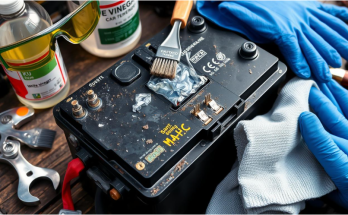Isn’t it rather uncomfortable to even imagine that somebody might be following your every step with the help of your car? At first, it may seem like something out of a James Bond movie. However, tracking devices are installed in cars than people can imagine. If you are in doubt with your partner, have some business conflict, or just want to feel safe and protected, you should know how to find out if your car is equipped with a tracking device.
What is a Tracking Device?
The tracking device can be defined as an object that is installed in a car and is used to point out the location of a particular car and its movement. Many of them incorporate GPS technology to convey information on the location of the salvaged vehicle to the person monitoring the same. There are various tracking tools available in the market, such as GPS tracking system, which is the most popular among all tracking systems, and RF (Radio Frequency) tracking system that uses radio signals for sharing information.
Signs Your Car Might Be Tracked
Now, you may be thinking if your car is being tracked or not. Here are some signs to watch out for:
- Unusual behavior of car electronics: When your car’s electronic systems start acting funny, it could be because of some sort of tracking device.
- Increased battery drain or fuel consumption: A tracking device, for example, may result in faster discharge of the car battery or even a drop in fuel consumption than expected.
- Suspicious individuals or vehicles around your car: If there is a car or woman whom you have never seen before and you see her or them trailing behind you or cruising around where your car is parked, they might be tracking you.
Why Someone Might Want to Track Your Car
There are various reasons why someone might want to track your car:
- Personal reasons: In stalking or domestic matters, the individual may always stay curious about whereabouts at any given time.
- Professional reasons: Tracking devices may also be used by repo agents when trying to find the place of a car that is to be repossessed, or companies may monitor their company cars.
- Criminal reasons: They might follow a car in order to steal it or, in order to learn your habits, to be able to burgle your house.
Types of Tracking Devices Used in Cars
Passive GPS Trackers
These devices have an internal memory and the data has to be taken physically in order to access the data stored in it. They do not give real-time location results but an entire location history.
Active GPS Trackers
These are advanced and can send data to the user as it is, that is, in a real-time manner. In many cases, they utilize cellular transmission to transfer information endlessly.
Radio Frequency (RF) Trackers
RF trackers work under the concept of radio frequency and they help to find where exactly a car is. They are not as frequent as the active ones but may still be employed in some circumstances.
OBD-II Port Trackers
These trackers connect to the OBD-II port, commonly located beneath the dashboard, and record the vehicle’s diagnostics and location.
Magnetic GPS Trackers
Magnetic trackers are portable and hence can be placed on a vehicle’s exterior, for instance, beneath another car or inside wheel wells, and they are discreet and difficult to spot.
How Tracking Devices Are Installed in Cars
Tracking devices can be placed almost anywhere in a car, but some common hiding spots include:
Undercarriage: Attached using magnets.
- Dashboard area: Concealed in the glove box or below the dashboard, too.
- Wheel wells: Especially magnetic devices.
- OBD-II port: Integrated into the car’s onboard diagnostics. This means they get their data directly connected to the car’s onboard diagnostics.
Tools Needed to Scan for a Tracking Device
To effectively search for a tracking device, you might need:
- Visual Inspection Tools: A torch and a mirror for the suspect who wants to check the areas they cannot easily observe.
- Electronic Scanning Devices: All equipment that can scan for signals, such as RF detectors and GPS trackers, for instance.
- Professional Help or Apps: In some instances, this is likely to necessitate the use of a professional, possibly carrying tracking gear that has particular tools or apps for the identification of trackers.
Step-by-Step Guide to Scanning Your Car
Step 1: Perform a Visual Inspection
Beginners with car painting can use a brush and paint the car in this way: first, concentrate on the underneath part of the car, including the wheel wells and the inside of the boot. Seek for anything that doesn’t fit in the surrounding environment.
Step 2: Check Common Hiding Spots
Start by checking the locations most of the devices are likely to be concealed; these include the dashboard area, behind the panels, or at the location of the OBD-II port.
Step 3: Use an Electronic Sweeper or Detector
An RF detector is used to search for the emanations of radio frequencies produced by trackers. The same applies to GPS detectors, as these can assist in detecting GPS-based devices.
Step 4: Consult from the Professionals
However, if you are unsure of what to search, it is advisable that you hire a professional to clean your vehicle to the finest detail.
Using Technology to Detect Tracking Devices
Unfortunately, it is nearly impossible to detect any hidden trackers without the proper technology and tools; today’s technology can be helpful in the search. Smartphones, for example, have apps that can be used to detect the signals coming from concealed devices, such as GPS detectors and RF scanners. Some apps are created to notify a user about unidentified Bluetooth devices or radio waves, which might mean there is a tracker nearby.
What to Do if You Find a Tracking Device
If you find a tracking device on your car, here’s what you should do:
- Don’t remove it immediately: Photograph the device. If it is pulled out too soon, it will alert the person who placed it and take many care measures to put it there.
- Report it to authorities: So call the local police, tell them about the device, and ask for their guidance on how to proceed.
- Seek legal advice: At times, you may knock on the service of a legal practitioner to get an idea of the way forward.
Conclusion
It may sound a bit intimidating to scan your car for a tracking device. However, it is perfectly doable if you are well-equipped and informed. In this regard, do not forget to pay attention to safety measures daily/periodical inspections and address the problems with the professionals. It is your right to protect your privacy, and learning to safeguard your car against tracking is an important step toward achieving it.
FAQs
Can I remove a tracking device myself?
Yes, but it’s advisable to document it first and consider involving law enforcement.
Are there signs that my car is being tracked?
Yes, unusual electronic behavior, increased battery drain, and suspicious vehicles can be indicators.
How often should I check my car for tracking devices?
Regularly, especially after parking in public or unfamiliar places.
Can a tracking device drain my car battery?
Some devices can cause increased battery drain, especially if they are actively transmitting data.
What should I do if I suspect someone is tracking me?
Conduct a thorough search, use detection tools, and consider involving professionals or law enforcement.

